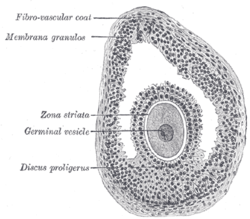Cumulus oophorus
| Cumulus oophorus | |
|---|---|
 Section of vesicular ovarian follicle of a cat. X 50. (Discus proligerus labeled at lower left.) | |
| Details | |
| Identifiers | |
| Latin | cumulus oophorus discus proliger |
| FMA | 18659 |
| Anatomical terminology | |
The cumulus oophorus (discus proligerus) is a cluster of cells that surround the oocyte both in the ovarian follicle and after ovulation. In the antral follicle, it may be regarded as an extension of the membrana granulosa. The innermost layer of these cells is the corona radiata.[1]
This layer of cells must be penetrated by
Functions
Functions of the cumulus oophorus include coordination of follicular development and oocyte maturation.
It also provides energy substrates for oocyte meiotic resumption and promotes glycolysis.[2]
Cumulus oophorus cells contribute heavily to the maturation and eventual fertilization of an oocyte. As a follicle grows in size and the antrum develops, more layers of cumulus oophorus cells accumulate around the oocyte to aid in the acrosome reaction and sperm penetration into the oocyte. The proximity between the cumulus oophorus cells and the oocyte favors bidirectional communication, which is vital for oocyte development.
Gene expression profiling
As a part of the process of
In gene
In contrast, genes where increased expression is correlated with lower oocyte competence or worse pregnancy outcomes include:
References
- ISBN 978-0878933846.
- ^ PMID 21896560.)
{{cite journal}}: CS1 maint: numeric names: authors list (link
External links
- Anatomy photo: Reproductive/mammal/ovary5/ovary3 - Comparative Organology at University of California, Davis - "Mammal, bovine ovary (LM, Medium)"
- UB, and UF) dbefruchtung/objectbefru01
- UIUC Histology Subject 366
- Histology image: 18404loa – Histology Learning System at Boston University - "Female Reproductive System: ovary, cumulus oophorus"
